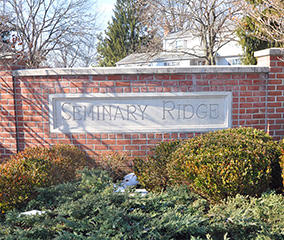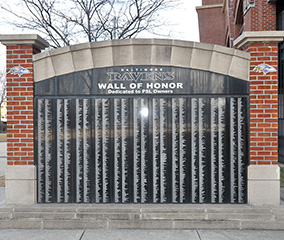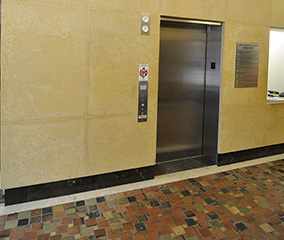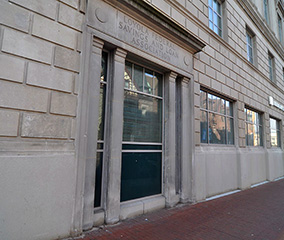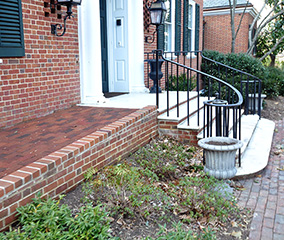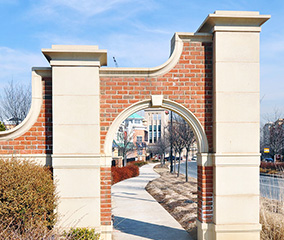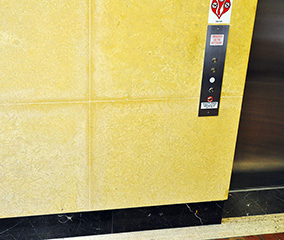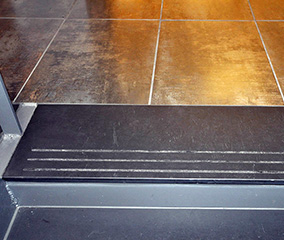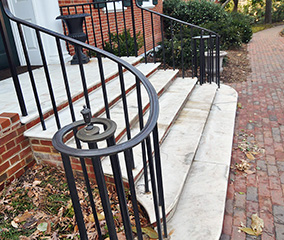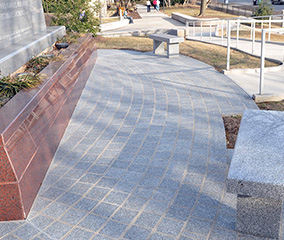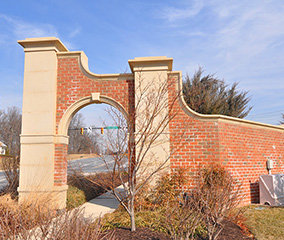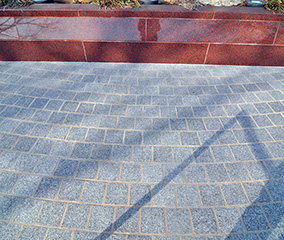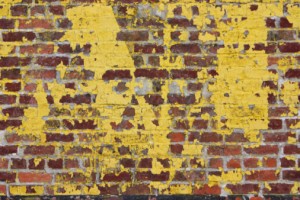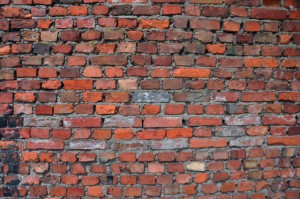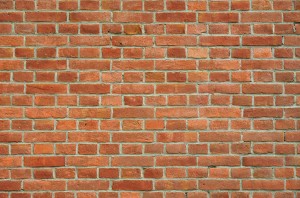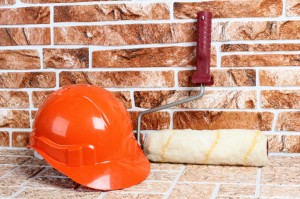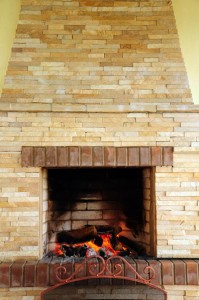Chimneys are known for durability, but that durability can lend homeowners to ignore masonry repair needs. Chimneys perform several important functions, and one that is deteriorating can be a safety hazard. As long as you keep up with maintenance and masonry repairs, however, you can extend the lifespan of your chimney and ensure it works properly. (more…)
Archive for the ‘ Brick ’ Category
Masonry Repair for Chimneys
Friday, April 8th, 2016How to Waterproof Bricks
Friday, February 26th, 2016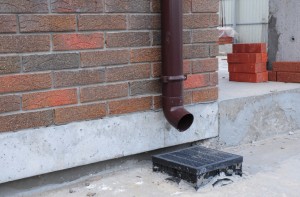
If you have bricks in an area where they may often get wet, you may want to consider waterproofing them.
Unsealed brick absorbs water, which can significantly threaten the integrity of porous brick masonry and mortar over time. Sealing and waterproofing the brick exterior of a home is a must, as it improves the home’s value by extending the life of its masonry in mortar. Especially in wetter climates, this is a must. If you live in a humid climate, be sure that the sealer you choose provides moisture protection. Follow these steps to waterproof bricks and ensure their longevity. (more…)
How to Remove Paint Streaks from Bricks
Wednesday, February 17th, 2016If the beautiful brick facade of your home is plagued by untidy-looking paint streaks, there is a definite solution. Follow these steps to keep your brickwork beautiful. Many consider options like sandblasting or acid treatment, and wonder if this is the sort of home repair they should even attempt without professional help. Take these tips and guidelines in mind when it comes time to remove pesky paint streaks and keep your brick beautiful. (more…)
Types of Surface Treatments for Antique Bricks
Monday, February 8th, 2016If you have antique brickwork, you may have noticed one of many different types of surface treatments that were popular at the time the brickwork was constructed. The surface of brickwork was often treated to lend uniqueness to the facade, update the brickwork, or fix a poor tuckpointing job. Here are three types of surface treatments for bricks that you may have noticed on your antique brickwork. (more…)
Tips for Tuckpointing Antique Brickwork
Friday, February 5th, 2016Tuckpointing is a way to remove old mortar between bricks and replace it with fresh new mortar. This is necessary if your brickwork is old and the mortar is crumbling. Adding new mortar can improve the structural integrity of old or antique brickwork. If you are considering tuckpointing some old brickwork, here are a few tips to consider. (more…)
Brick Veneer vs. Solid Brick
Friday, January 29th, 2016Brick veneer and solid brick structures use some of the same construction materials, but their installation techniques are different. Brick veneer is not, contrary to popular belief, composed of thin pieces of brick though it looks almost identical to a solid brick structure. Brick veneer is constructed from steel or wooden framing, covered with wood sheathing or insulation. A single layer of brick is built near each exterior wall and held fast with metal ties. Veneer brick does not support the structure of the house but serves an entirely cosmetic function. There are many benefits and advantages to this method. (more…)
Should I Paint My Brick Wall?
Tuesday, January 5th, 2016Ooh, exposed brick! How lovely! But might it look even lovelier with a gleaming new coat of bright white paint? Oh, the possibilities! Ultimately, the choice is up to you whether you want to maintain the beautiful and rustic clay color or make your brick surfaces stand out from the rest with a fresh coat of paint. The best we can offer is some advice before you take on the project. (more…)
How to Clean Interior Brickwork
Friday, December 18th, 2015You may have read our blog on cleaning exterior brickwork. The methods listed there are great for cleaning walls and walkways outside, but if you’re planning on cleaning inside brickwork, you’ll need to follow a different set of instructions. DelPrete Masonry is here to help you keep all of your brickwork looking as clean and new as possible! You may have a fireplace in your home that you’re thinking of firing up to use for roasting marshmallows or making popcorn. Or perhaps you have a rustic brick wall in your kitchen that needs a good cleaning. When brickwork is in your home, it’s both important to keep it clean as well as use safe cleaning methods. Follow these methods to have pristine, safe interior brickwork! (more…)
How to Clean Exterior Brickwork
Sunday, November 22nd, 2015
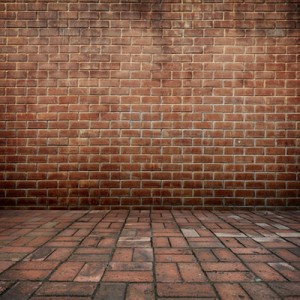
If your brickwork looks like it needs a good cleaning, make sure that you’re using the safest and most effective cleaning methods!
Bricks can be either sealed or unsealed; of course, unsealed bricks require more maintenance to keep up their appearance. Exterior bricks especially should be cleaned regularly. With winter approaching, exterior bricks easily build up salt, dirt, and grime. Make sure that your brickwork is looking its best with our cleaning tips.
Bucket and Brush Method
The bucket and brush method of cleaning is the most widely used and efficient means of cleaning brickwork. It does not require advanced equipment or skill, and it is easy and quick. Here are the steps required to clean your brickwork with this method:
- If your masonry is brand new, wait at least a week to give it its first cleaning. Use a scraping tool to rough away any hardened particles of mortar.
- Use a generous amount of water to saturate the brick wall. This will ensure that the wall does not develop any stains from cleaning, as dry bricks absorb dirt into their brick pores. Using a regular hose, and make sure all the bricks as well as the base of the masonry is drenched.
- Starting from the top, use a long-handled fiber brush to scrub cleaning solution onto the bricks. Sure Clean, Goldblatt Brick Bath, and Superior 800 series are all good choices for cleaning solutions. Be sure to ask your professional mason for their recommended ratios of solution to water.
- After scrubbing, allow the solution to sit and soak for three to six minutes. After soaking, wash off with the hose. Make sure that you’re washing only small parts of the brickwork at a time, rather than the entire wall or walkway. This will ensure that the bricks don’t dry and absorb stains that are impossible to remove.
- Tip: if your bricks are old and weathered, a better way to clean them is to simply use a duster or broom to sweep off dirt and grime. If you think your old bricks can withstand a tougher cleaning, start by testing a small corner first.
Keep Your Masonry Looking Good with Del Prete Masonry!
While there are many other materials that we use at Del Prete Masonry, we’re not about to abandon concrete anytime soon. It has proven its worth many times over and we know that we can bring you a solid masonry structure with it. To find out more about your masonry options including concrete masonry, please contact our office today at 410-683-0650 or email us at mike@delpretemasonry.com. We serve Baltimore City, County, Harford County, Carroll County, Anne Arundel County, and Howard County. Keep up with our blog for masonry related information, and follow us on Facebook, Twitter, and Google+.
Tips for DIY Brickwork
Saturday, November 7th, 2015While some projects will require a professional masonry service, there are other DIY brickwork projects that the average homeowner can complete.
Of course, proper preparation is most important when planning a DIY brickwork project. But, it’s also important that you have the right tips. Listed below are a few tips from Del Prete Masonry to help you get started on your DIY brickwork projects.
Purchase the Proper Tools
Before you start any projects, you want to make sure that you have all of the tools you need to complete your brickwork project efficiently. The last thing you want to do is have to run to the hardware store or order a specialty tool right when you are in the middle of your brickwork. Some of the tools you will need for your DIY project are spades and shovels, buckets, spot boards, bricklaying trowels, tape measures, bolster chisels and a soft hand brush just to name some of the most common tools for brickwork projects.
Focus on Safety
For any DIY project, especially a masonry project, you want to make sure that you and the individuals you are working with are completely safe. During some point of your brickwork, you will most likely find the need to cut some bricks to a certain size. When you do this, make sure that you and everyone working with you has his or her safety goggles on. Goggles are just like any of the tools you use, and goggles are necessary for your DIY brickwork.
Laying Bricks
Laying bricks is an art for a professional masonry service, but you can complete a basic brickwork project with a few tips. Always make sure that when you lay bricks the vertical joints are staggered. This gives the brickwork more support and strength. Also, remember that not all bricks are going to be perfectly square, so use your best judgment on whether you feel you need to cut the bricks. For any extensive projects, make sure to work with professional masonry service to make sure your project is absolutely perfect.
Del Prete Masonry
For any questions regarding new masonry construction, feel free to contact Del Prete Masonry. Our masonry restoration professionals have the experience and history of satisfied clients to prove that we’ll get the job done right, and cost-effectively. To get started with your masonry restoration project, please contact our office today at 410-683-0650 or email us at mike@delpretemasonry.com. We serve Baltimore City, County, Harford County, Carroll County, Anne Arundel County, and Howard County. Keep up with our blog for masonry related information, and follow us on Facebook, Twitter, and Google+.








